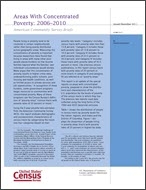Areas With Concentrated Poverty: 2006–2010
Areas With Concentrated Poverty: 2006–2010
Introduction
People living in poverty tend to be clustered in certain neighborhoods rather than being evenly distributed across geographic areas. Measuring this concentration of poverty is important because researchers have found that living in areas with many other poor people places burdens on low-income families beyond what the families’ own individual circumstances would dictate. Many argue that this concentration of poverty results in higher crime rates, underperforming public schools, poor housing and health conditions, as well as limited access to private services and job opportunities.1 In recognition of these burdens, some government programs target resources to communities with concentrated poverty. Many of these programs use the Census Bureau’s definition of “poverty areas” (census tracts with poverty rates of 20 percent or more).2
Using the 5-year poverty rate estimates from the American Community Survey (ACS), this report analyzes demographic and socioeconomic characteristics of census tracts by categorizing the tracts into four categories based on their poverty rate levels.3 Category I includes census tracts with poverty rates less than 13.8 percent.4 Category II includes those with poverty rates of 13.8 percent to 19.9 percent. Category III includes those with poverty rates of 20.0 percent to 39.9 percent, and Category IV includes those tracts with poverty rates of 40.0 percent or more. Like previous census publications, in this report census tracts with poverty rates of 20 percent or more (tracts in category III and category IV) are referred to as “poverty areas.”
This report is an update of the special reports on areas with concentrated poverty, prepared to show the distributions and characteristics of the U.S. population by the levels of poverty of the census tracts in which they live. The previous two reports used data collected using the long forms of the 1990 and 2000 decennial censuses.
Table 1 shows the distribution of people in census tracts by poverty levels for the nation, regions, and states and the District of Columbia. Figure 1 displays the proportion of people living in poverty areas (tracts with poverty rates of 20 percent or higher) by state.
__________
1 See for example, The Enduring Challenge of Concentrated Poverty in America: Case Studies from Communities across the U.S.A., A joint Project of the Community Affairs Offices of the Federal Reserve System and the Metropolitan Policy Program at the Brookings Institution. (Federal Reserve Bank of Cleveland, 2008).
2 For example, the Developmental Disabilities Assistance and Bill of Rights Act in Section 103(a) allows Basic State Grant projects whose activities or products target poverty areas to receive as much as 90 percent in federal support and the New Market Tax Credit (NMTC) program, enacted in December 2000 as part of the Community Renewal Tax Relief Act, defines eligibility as projects in census tracts with a poverty rate of at least 20 percent.
3 The ACS collects and releases data by calendar year for geographic areas that meet specific population thresholds. One-year estimates are published for areas with populations of 65,000 or more, 3-year estimates for populations of 20,000 or more, and 5-year estimates for populations of almost any size. ACS 1-, 3-, and 5-year estimates are period estimates, which mean they represent the characteristics of the population and housing over a specific data collection period. Data are combined to produce 12 months, 36 months, or 60 months of data.
4 According to the 5-year ACS, the poverty rate for all people in the United States was 13.8 percent.
Others in Series
Publication
Publication
Publication




